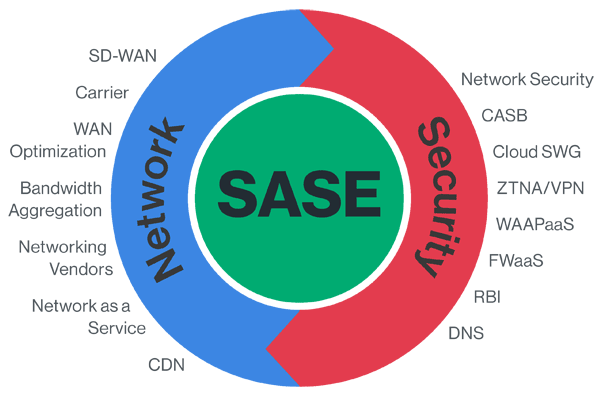SASE Technologies

At the beginning and with the implementation of ICT technologies, private infrastructures were set up for each of the companies, with their final equipment, network equipment, servers, storage units and others. As new technologies came out, this equipment was changed and updated to ensure that it was covered against security leaks and thus promote a safe company. Today, however, and continuing with the movement that has started in recent years, on-premise infrastructure applications are being brought into the cloud, see email servers such as Exchange, ICT infrastructures such as AWS or Azure, and many other services and applications. Due to this, protecting the company's ICT infrastructure is no longer always sufficient due to the use of external resources, and a further step must be taken in the protection of communications. This is where SASE comes in.
SASE, or in other words Secure Access Service Edge is an emerging, cohesive but incremental infrastructure approach to creating a new context for the IT world. It is implemented over software-defined wide area networks (SD-WAN), thus integrating cybersecurity capabilities, features, and tools. These services can be managed in cloud deployments and delivered on-premises or through the cloud itself, depending on user requirements.
Gartner estimates that by 2024, at least 40% of companies will have adopted a SASE strategy, up from 1% in 2018.
Even so, and having given the context and meaning of SASE, there are certainly compelling reasons that promote the implementation of a SASE strategy. Among them we can find:
- Reduces network-related complexity and costs.
- New open fronts, as well as scenarios and possibilities to address for business.
- Provides unified security and complies with Zero Trust policies.
- Reduces operating costs.
- Improves performance and reduces latency.
- Increases the effectiveness of security personnel.
Having said this, it can be concluded that SASE is a very powerful unified security tool and that it will mark the future of the new decade in terms of operability and security. This is also corroborated by Gartner through the following graph from last year according to the hype cycle regarding cloud security.

For now, it is already functional, and this is how Ignacio Franzoni, a systems engineer at Netskope, showed us with the products and services they have developed, and the POP (Point of Presence) infrastructure that is used.